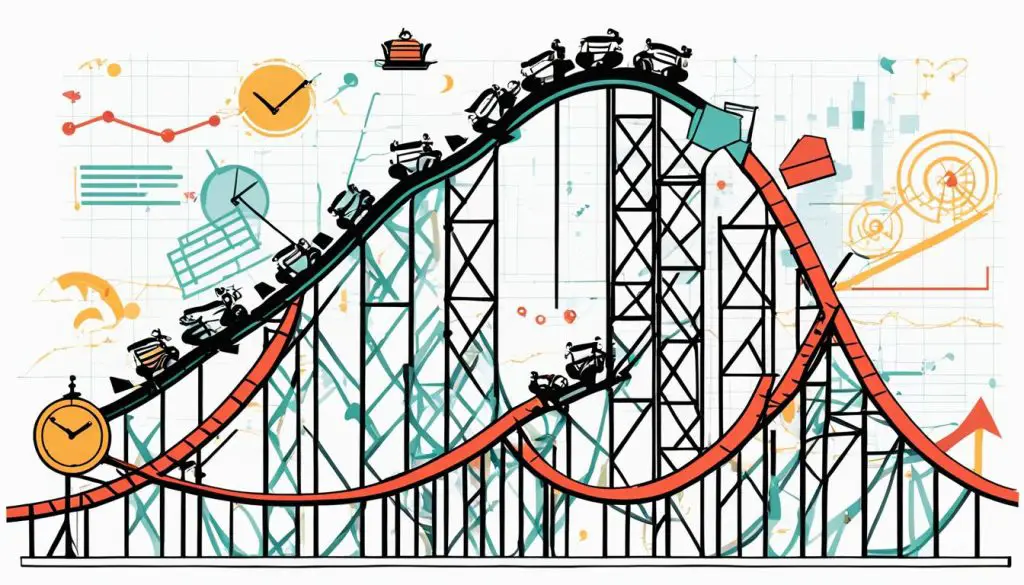When the COVID-19 pandemic unfurled its uncertainty across the globe in early 2020, the ripple effects tore through the financial landscapes, marking the start of the covid stock market crash. A sense of anxiety and trepidation gripped investors as nation after nation grappled with the emerging health crisis. The economic impact of covid on the stock market was swift and merciless, eroding gains and disrupting market equilibrium within weeks.
The widespread fiscal trepidation transgressed into a full-blown economic crisis during covid, as equity markets faced record-breaking plunges. The descent into what will be historically chronicled as the COVID-19 recession saw a multitude of factors converging—from pandemic-driven market liquidity crises to burgeoning recession fears. This turbulence in the stock markets not only reflected the immediate response to the escalating pandemic but also signified the end of an era characterized by unabated economic expansion and low unemployment worldwide.
Prelude to the Crash: Warnings and Early Signs
Even before the full-scale onset of the COVID-19 pandemic, certain financial indicators were already hinting at an impending economic turmoil. Among these were the unsettling yield curve inversions in the U.S. Treasury Securities market. Beneath the surface of a seemingly robust global economy, these signals were clear harbingers that forecasted the potential for the tumult that lay ahead—a phenomenon that would become the pandemic’s effect on the stock market.
Yield Curve Inversions and Preceding Slowdown in Global Economy
Throughout 2019, financial analysts observed with concern the inversion of the yield curve—a situation where short-term debt instruments yield higher returns than long-term ones, which is commonly seen as a predictor of recession. Concurrently, the global economy was not in its prime. The International Monetary Fund (IMF) stressed the dampening effects of the intensifying trade tensions, notably the China-United States trade war, and political uncertainties such as Brexit—all ingredients contributing to the synchronized economic slowdown that was observable across various nations.
Financial Markets Respond to Early COVID-19 Outbreak
As the World Health Organization (WHO) declared a Public Health Emergency of International Concern in January 2020, financial markets experienced volatility that would foreshadow the stock market downturn due to COVID. The initial market response was mixed: treasury yields oscillated, oil prices wavered, and countries like Singapore and Indonesia implemented fiscal strategies in attempts to stave off the threatening covid-induced stock market decline. This phase of flux was marked by both apprehension and reactive policy-making.
| Indicators | Pre-COVID (2019) | Post-COVID Declaration (Early 2020) |
|---|---|---|
| Yield Curve Status | Inversion Noted | Further Inversion |
| Market Volatility | High | Increased |
| Policy Responses | Limited/Preventative | Emergency Measures |
| Global Economic Outlook | Slowdown | Recession Predicted |
The journey towards the stock market crash was underscored by these subtle yet significant shifts. Investors and policymakers alike navigated a landscape ripe with challenges, setting the stage for the world to grapple with an unprecedented economic scenario shaped by a global health crisis.
Covid Stock Market Crash: A Timeline of Events
The tumultuous episodes of early 2020 will forever be etched in the annals of financial history, marking an era of covid stock market volatility unlike any witnessed before. As the world grappled with the onset of the COVID-19 pandemic, the stock market experienced a sequence of events that would lead to a significant stock market crash during covid. This timeline charts the critical points where global markets shifted from uncertainty to a bear standoff, fundamentally altering the economic landscape.
Circling the dates on the calendar, investors watched with dread as February waned, spiking tensions into March. The Dow Jones Industrial Average, one of several indices to encapsulate this downturn, was jostled by alarming one-day drops, symptomatic of a broader market instability. Historical moments of capitulation, labeled Black Monday I, Black Thursday, and Black Monday II, signposted sharp declines, inciting decisive reactionary policies from the world’s central banks and governments.
- March 9th, dubbed Black Monday I, saw the Dow crumble over several trading hours, with a staggering point descent.
- March 12th, known as Black Thursday, further unsettled the markets, culminating in a near 10% plummet.
- March 16th was christened Black Monday II, a day of intensified distress, leading to another historic nosedive in market valuations.
These critical days, frenzied with panic selling and liquidity crunches, thrust the global economy into unprecedented chaos. Specialist teams, formed by central investors and economic policymakers, put forth efforts to stabilize the fray, with interventions and stimulus plans that pried open the throttling hands of a bear market at the throat of global finance.
Black Mondays and Black Thursday: Record-Setting Days
The onset of the COVID-19 pandemic triggered an unprecedented response in global markets, with some of the most significant single-day downturns ever recorded occurring in March 2020. These historic events became milestones in financial history and have since been extensively analyzed for their broader economic implications.
Dow’s Historical Point Plunge: Black Monday I
On March 9, 2020, a day that came to be known as Black Monday I, the Dow Jones Industrial Average saw a dramatic fall of over 2,000 points. It was a stark representation of the covid stock market crash, as panic over the spread of the virus, travel bans, and oil price wars rattled investors worldwide.
The Fall of Global Markets: Black Thursday
Following closely on the heels of Black Monday I, Black Thursday, March 12, was marked by a nearly 10% nosedive in stock values. This stock market crash during covid was not confined to the United States; markets globally felt the shockwaves of concern over the pandemic’s acceleration and its associated economic impacts.
Intensified Downturn: Black Monday II
The second Black Monday, occurring on March 16, deepened the financial distress as the Dow Jones plummeted nearly 3,000 points. Seen as an escalation of the market reactions from the previous week, this day underscored the severity of the market’s reaction to covid-related disruptions.
The sharp declines across these major trading days created significant concern for long-term economic stability and prompted a worldwide discourse on recession and recovery strategies. Below is a table summarizing the record-breaking drops:
| Date | Event | Points Dropped | Percentage Change |
|---|---|---|---|
| March 9, 2020 | Black Monday I | Over 2,000 | N/A |
| March 12, 2020 | Black Thursday | N/A | ~10% |
| March 16, 2020 | Black Monday II | Nearly 3,000 | N/A |
Investors and policy makers alike closely examined these tumultuous events for insights into market dynamics in crisis situations, hoping to derive strategies that might prevent or mitigate such crashes in the future.
Market Response and Monetary Policy Interventions
Amidst a climate of uncertainty and rapid decline, the Federal Reserve played a pivotal role in stabilizing the economy, influenced by the economic impact of COVID on the stock market. Reflecting on the gravity of the downturn, the Fed implemented a swift interest rate cut in March 2020 to near-zero levels, aiming to curb the market descent and stimulate economic activity. This crucial decision laid the groundwork for financial recovery and demonstrated the Federal Reserve’s commitment to bolstering market stability.
In concert with interest rate reductions, a historic financial stimulus package amounting to $2.3 trillion was introduced, marking a significant milestone in the U.S. economic policy. This influx was part of a comprehensive strategy to mitigate the distress felt by businesses and investors alike, addressing liquidity crises and restoring confidence within the markets. These interventions signified a potent response to the economic impact of COVID on the stock market and underscored the Federal Reserve’s role in cushioning the pandemic’s blow to the global economy.
The collective impact of these monetary policies catalyzed a surprising yet robust recovery, sparking a wave of optimistic sentiment among investors. This turnaround resulted in a bullish trend on Wall Street, culminating in the Dow Jones Industrial Average breaching the unprecedented 30,000-point threshold in November 2020. Such a remarkable rebound illustrated the effectiveness of the Federal Reserve’s measures in not only providing immediate economic relief but also setting a strong foundation for a durable resurgence post-pandemic.
FAQ
The causes of the COVID stock market crash included pandemic fears which led to liquidity crises, recession concerns, and exacerbated the effects of a pre-existing global economic slowdown. This was in part due to prior signals such as the inverted yield curve indicating potential recession, heightened geopolitical tensions, and significant uncertainty surrounding the ramifications of the COVID-19 pandemic.
Early signs included the inversion of the U.S. Treasury yield curve from May to October 2019, signaling an increased risk of recession. There was also a synchronized slowdown in the global economy due to trade tensions and other geopolitical issues such as the China–United States trade war and Brexit, which set a fragile stage even before COVID-19 became a global health emergency.
Financial markets initially responded to the COVID-19 outbreak with volatility, experiencing fluctuations in treasury yields and oil prices along with modest rebounds, until the growing severity of the pandemic sparked a full-blown market crash. The turns were sudden and sharp, indicating the market’s sensitivity to the unfolding crisis.
These dates were termed Black Mondays and Black Thursday because they each marked some of the largest point drops in the history of the Dow Jones Industrial Average at the time. The use of “Black” in finance typically denotes days of heavy losses and market crashes, reflecting the somber economic atmosphere on those days.
While the economic impact of COVID was felt universally, different markets and sectors experienced varying degrees of volatility and recovery. For example, technology stocks surged due to increased demand for digital services, whereas industries like travel and hospitality faced prolonged downturns.
The Federal Reserve’s actions, which included interest rate cuts and the injection of enormous liquidity into the economy through a stimulus package, worked to ease market conditions, ensure the continuous operation of financial markets, and persuade investors of the government’s commitment to economic stability and recovery.






